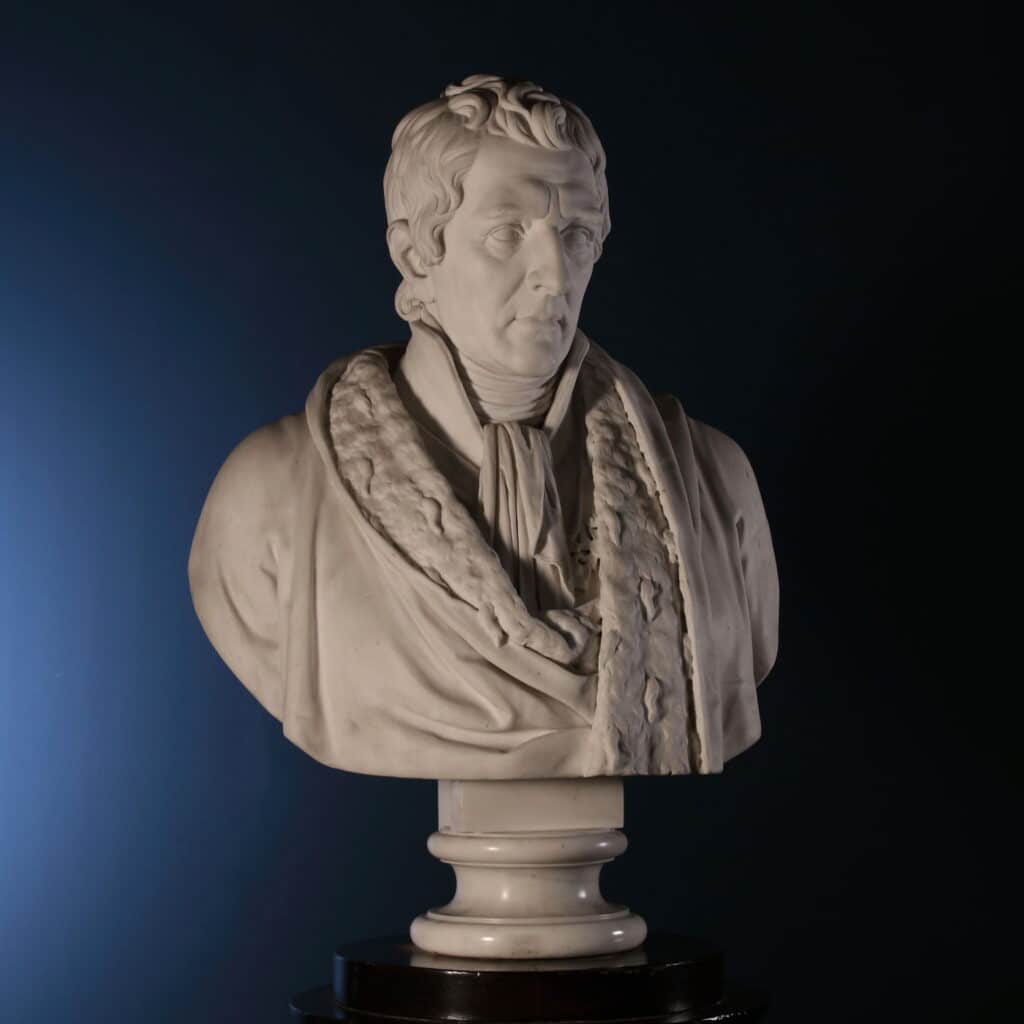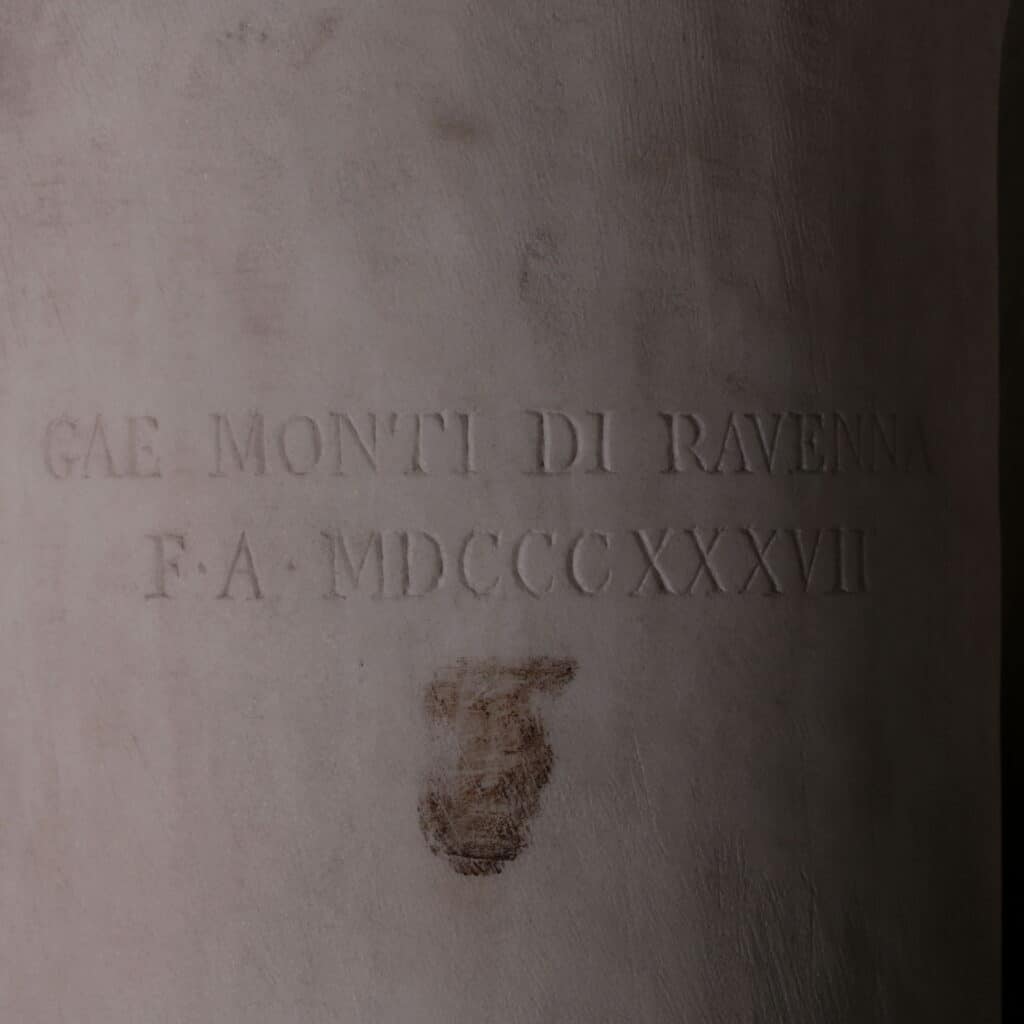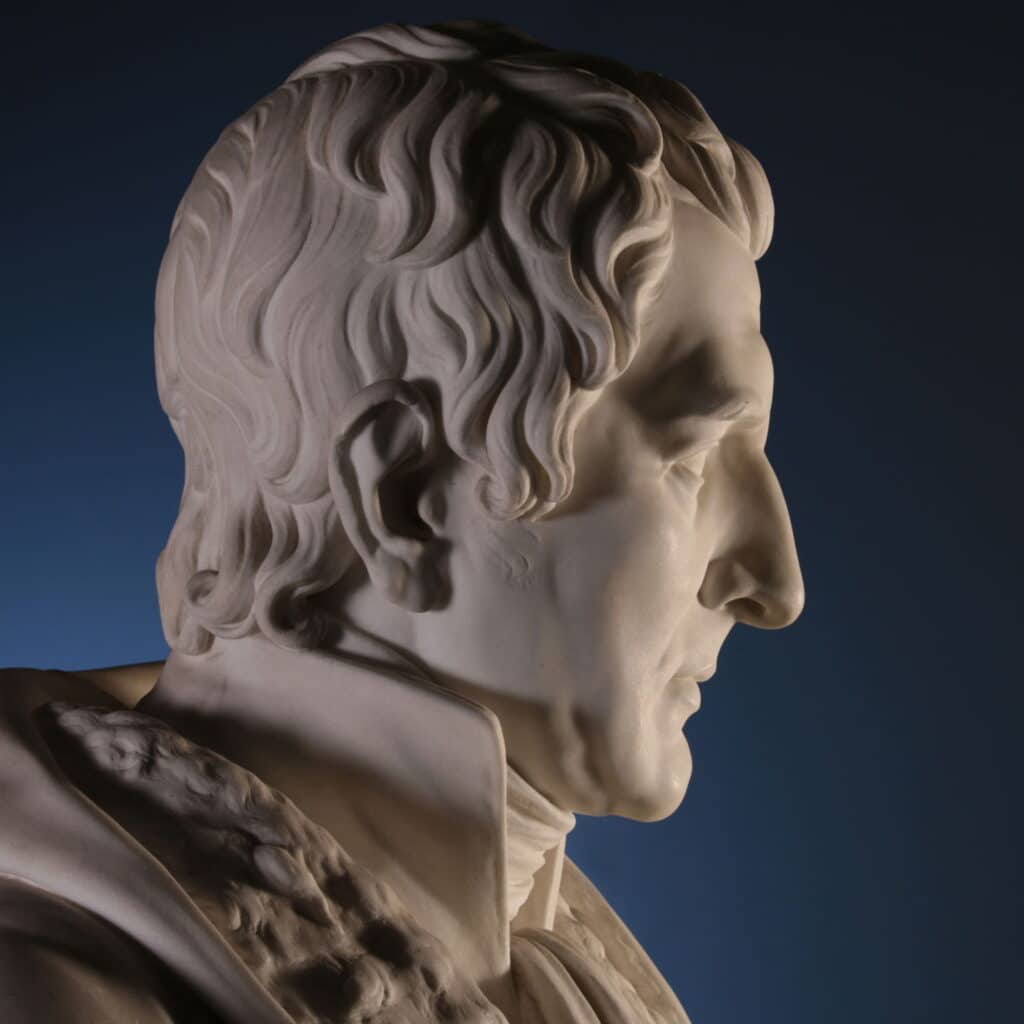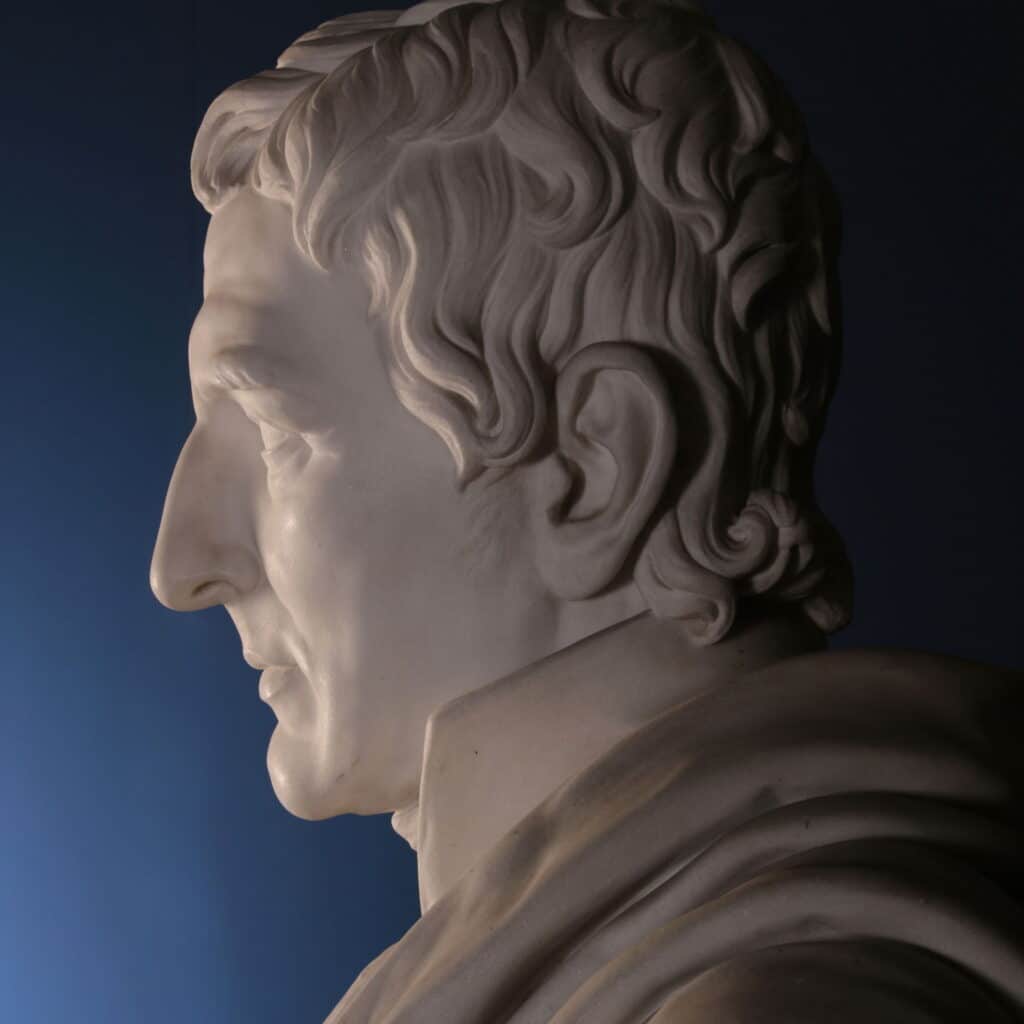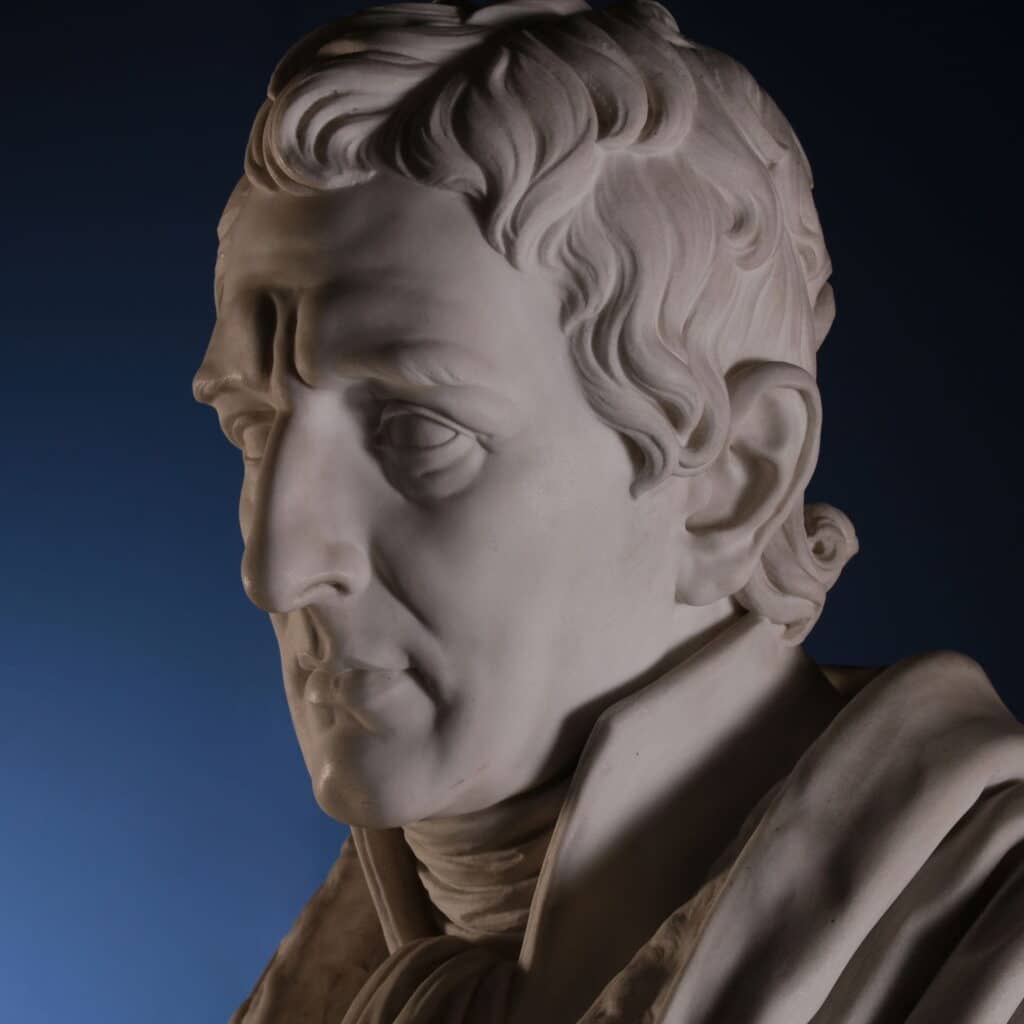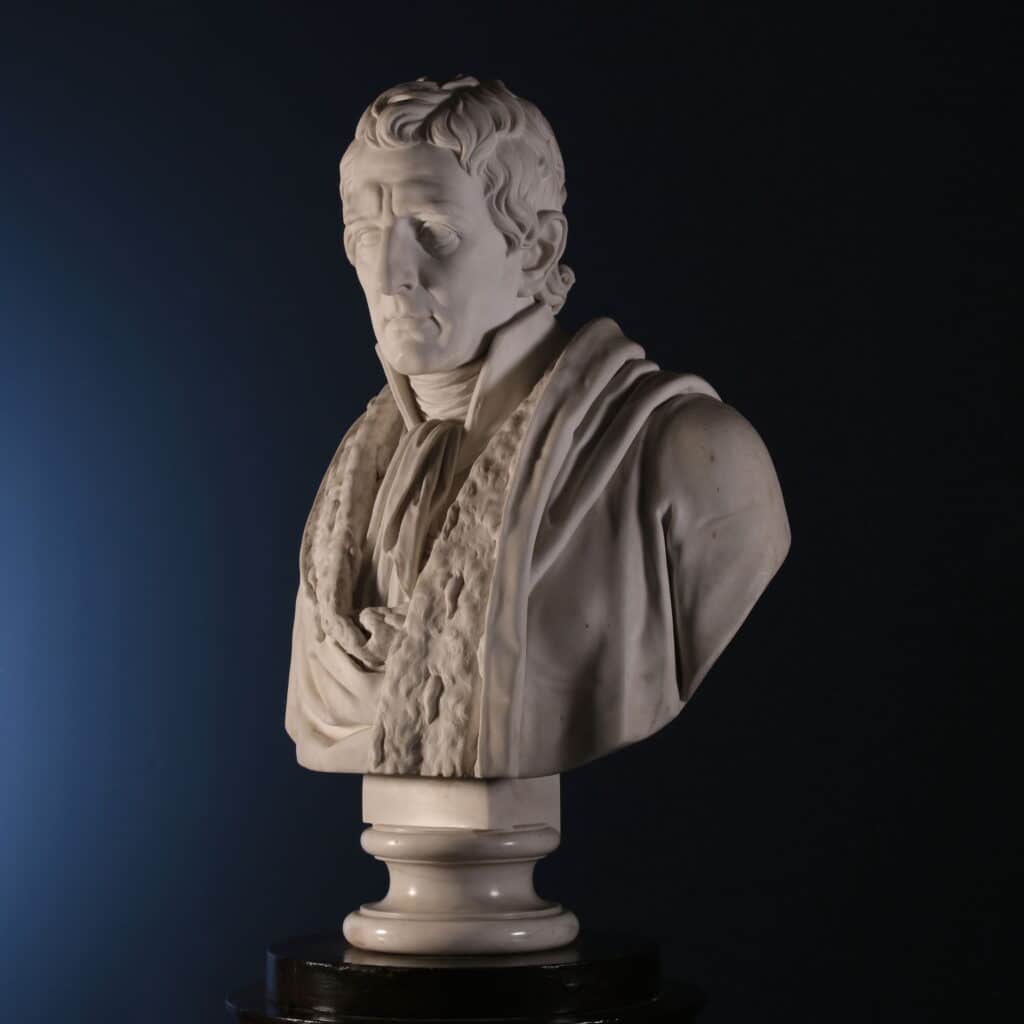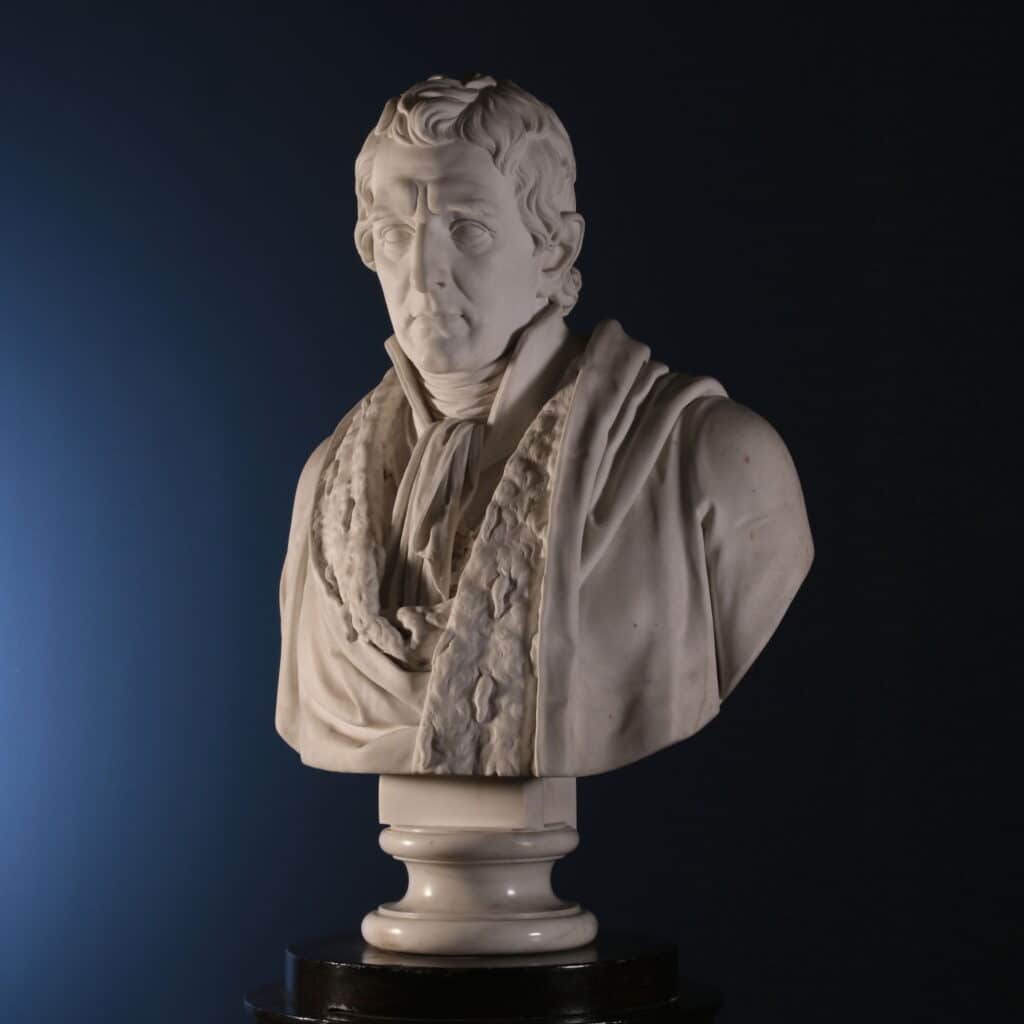Bust of Baron Antonio Negri, Gaetano Monti, 1837
Gae. Monti di Ravenna F.A. 1837
Bust of a nobleman in white marble
Description:
The portrayed is Baron Antonio Paolo Negri. The bust has a celebratory aim, as per the customs of the time and therefore made with larger dimensions than the real ones. The face is slightly inclined, the gaze fixed and proud: the severe and haughty expression recalls the heroic atmosphere of the Napoleonic age. The face is elongated and well proportioned. The “Brutus” hairstyle, with short hair and irregular fringe on the forehead, is soft and finely crafted. The forehead is high and wide, wrinkled and marked by time. The prominent nose is a typical expression of the subject’s virility and strength. The mouth is tight, the lips thin: no emotion shines through. The oval-shaped face is underlined by the pronounced dimple chin. The figure is composed and refined, both in the rendering of the somatic features and in that of the clothes.
The Baron’s clothing recalls the typical canons of the time: shirt with stand-up collar and raised points, tie tied to a gala and long lapel cape with ermine brim.
To highlight the refinement and plasticity in the creation of the bow of the tie and in the rendering of the collar of the overcoat, to recall the softness of furs. On the chest the symbols of the honors of the noble, member of the legion of honor and knight of the order of the Iron Crown: the star with five bifurcated rays, surmounted by a crown, is pinned on the left side of the chest; the coat of arms of the order of the Iron Crown, with iron horns surmounted by a double-headed eagle, is instead hanging around the neck.
The bust, coming from Villa Negri in Casinetta di Lugagnano, recalls a painting owned by the family in which the Baron himself is represented in official clothes. As President of the Court of Cassation he is depicted wearing a red gown edged in ermine, a tie tied to a gala and a jacket. The coat of arms of the Legion of Honor is clearly visible, pinned on the left side of the chest, with a red ribbon, and that of the Order of the Iron Crown, hanging around the neck with a yellow ribbon edged with green. On the painting, the noble coat of arms of the Negri family appears at the top left: “Porta split semipartito in capo; first, in silver with a crow resting on a black wheel; second, Franco de ‘Baroni drawn from the Corte di Cassazione which is red with a silver balance moving from the top of the head; above the blue with two black books placed in the band “(ref. Archive …).
Dimensions: base 90 x 64 x 38 cm, height 115 cm, diameter 48 cm
CODE: ARTART0000177
Historical-artistic analysis:
In 1802 Napoleon established the Legion of Honor as an honorary reward to military and civilians, both in France and in Italy. The various ranks of the Legion of honor were knight, officer, commander, grand officer and grand cross decorated with grand cordon. Membership in the association was not only a reward but also an incentive to operate in important charitable activities. The symbol of the legion of honor was a star with five bifurcated rays, surmounted by a crown, with the inscription “Napoléon, empereur des Français” on one side and “Honneur et patrie” on the other, with the imperial eagle. The ribbon was red, in memory of the Phrygian cap and the ribbon of the St. Louis cross. The decree of 30 January 1805 instituted the great decoration, or great eagle (which later became the great cordon). The decoration was worn, depending on the degree, on a pendant around the neck, in the buttonhole with a rosette or hung without a rosette.
In this specific case, Baron Negri is depicted with the five-pointed star pinned, as per the tradition of the order of knights, on the left side of his chest with a red ribbon without a rosette.
The Order of the Knights of the Order of the Iron Crown was established in 1805 by Napoleon I for the Kingdom of Italy.
At first the order was to consist of 500 knights, 100 commanders and 20 dignitaries; with the decree of 19/12/1807 300 knights, 50 commanders and 15 dignitaries were added. The dignitaries organised the Grand Council of the Order. The knights and commanders had to meet in the General Chapter every year on Ascension Day in the Milan Cathedral to take an oath of loyalty to the King of Italy. After the fall of Napoleon, the Austrian Emperor Francis I decided to keep the Order.
Biography of Antonio Paolo Negri:
Antonio Paolo Negri, lawyer of a noble and very ancient decurional family of Pavia, was a prominent personality in the political panorama between the thirteenth and nineteenth centuries. He was born in Milan in 1761, son of Carlo (of Gerolamo), royal notary of the chamber, and of Giulia dei Conti Rottigni. The family was given the fiefdom of “Torre de ‘Negri and Cassina del Melano” on 8 June 1697 and was given the title of count of the Torre de’ Negri on 13 January 1717 for the Diploma of Emperor Charles VI.
He studied literature at the Somascan college in Merate and graduated in civil and economic law at the University of Pavia. Not yet twenty-four he was elected royal procurator of the poor and two years later he was called to help the royal tax office.
In 1789 he became councilor at the I.R Court of first instance in Milan of which in 1796 he became president. Member of the jurisprudence committee, government commissioner at the Supreme Court, in 1797 he was elected member of the Court of Cassation. In 1807 he was appointed president of the court of cassation, then a member of the commission charged with implementing the project of the Criminal Code of the Kingdom of Italy.
Antonio Paolo Negri was then a member of the legion of honor, a knight of the order of the iron crown, as well as a member of the electoral college of the learned. He was appointed Baron of the Kingdom with R. Dispaccio of 7 February 1810 by the Emperor Napoleon I (D. 7 February 1810, Law 28 March 1812), a title that was later forfeited due to the failure to train a majorascus. In 1827 he accepted the post of noble deputy at the Provincial Congregation of Milan conferred on him by the I.R. Government of Lombardy, and in 1829 that of member of the municipal council. He died on January 18, 1856 in Milan.
The Napoleonic title fell due to the lack of training of a majorasco: his brother, Cav. Gaetano Negri della Torre, with Dispatches of 25 November 1816 and 14 August 1817, had reconfirmed the ancient nobility and the count’s title with succession for legitimate and natural males.
Antonio Paolo Negri appears in the lists of persons awarded the titles of duke, baron, knight, by Napoleon in the Kingdom of Italy (1807-1814) and in that of the decorated of the order of the Iron Crown.
Our pair of sculptures belongs to the production that spread in the second half of the 19th century, in the context of the revival of the stylistic currents of the past and particularly pertinent to what was called Neo-Baroque. The figures are in fact characterised by the pastiglia-shaped texture of the fabrics, an execution method typical of the period, as well as an exotic and oriental flavour in the decorations of the garments, clearly an expression of eclecticism, dictated by the heterogeneous figurative influences at the end of the 19th century. Several other specimens are known with which interesting comparisons are possible, such as the pair moors that hold a candelabra in the Museo d’Arti Applicate of the Castello Sforzesco. As mentioned in the catalogue entry, similar figures can be found in the mail order catalogue of the Sarfatti company, published in 1887. However, this was not the only firm that specialised in wood carving in the neo-Baroque style: the existance of the workshops of Valentino Besarel (1829-1902), Vincenzo Cadorin (1854-1925), Marco del Tedesco (active in 1887) and Francesco Taso (active in 1878) was well known those years.
Bibliography:
– M.G. Borghi, G.M., scultore ravennate (1776-1847), accademico nella Imperiale Regia Accademia di belle arti a Brera in Milano dal 1816 al 1847, in Rediconti dell’Istituto lombardo di scienza e lettere, s. 3, XI (1947), pp. 132-148;
– G. Viroli, Il gesto sospeso. Scultura nel Ravennate negli ultimi due secoli, Ravenna 1997, pp. XIII, 57-65, 238;
– A. Panzetta, Nuovo dizionario degli scultori dell’Ottocento e del primo Novecento, II, Torino, 2003, p. 587;
– A. Imbellone, in Canova. L’ideale classico tra scultura e pittura (catal., Forlì), a cura di A. Androsov – F. Mazzocca – A. Paolucci, Cinisello Balsamo 2009, pp. 170 s., n. III, 1;
– Giacomo C. Bascapé e Marcello Del Piazzo, Araldica Napoleonica in Italia, Ministero dei beni culturali;
– Ruggero Moscati, a cura di, Le scritture del minister degli affair esteri del regno d’Italia dal 1861 al 1887, Tipografia del minister Affari esteri 1953.
- Bust of Baron Antonio Negri, Gaetano Monti, 1837

Antiques, Art and Design
FineArt is the new ambitious Di Mano in Mano project that offers an exclusive choice of antiques and design works, presenting them for their singularity and uniqueness.

